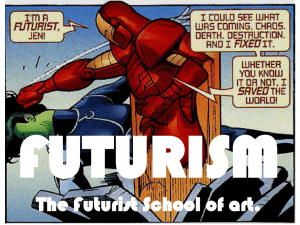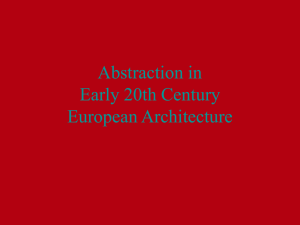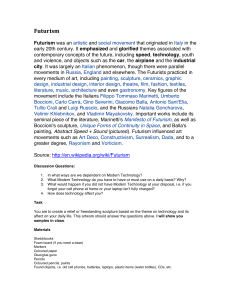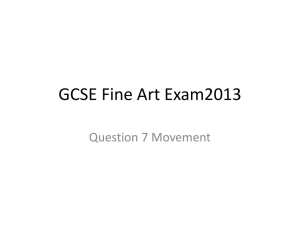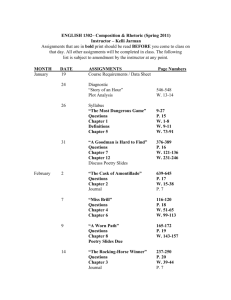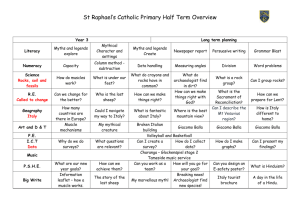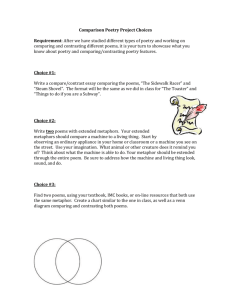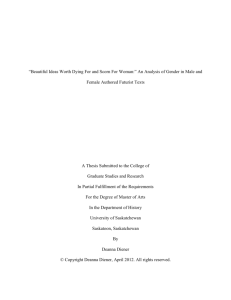FUTURA 1 notes - erratum
advertisement
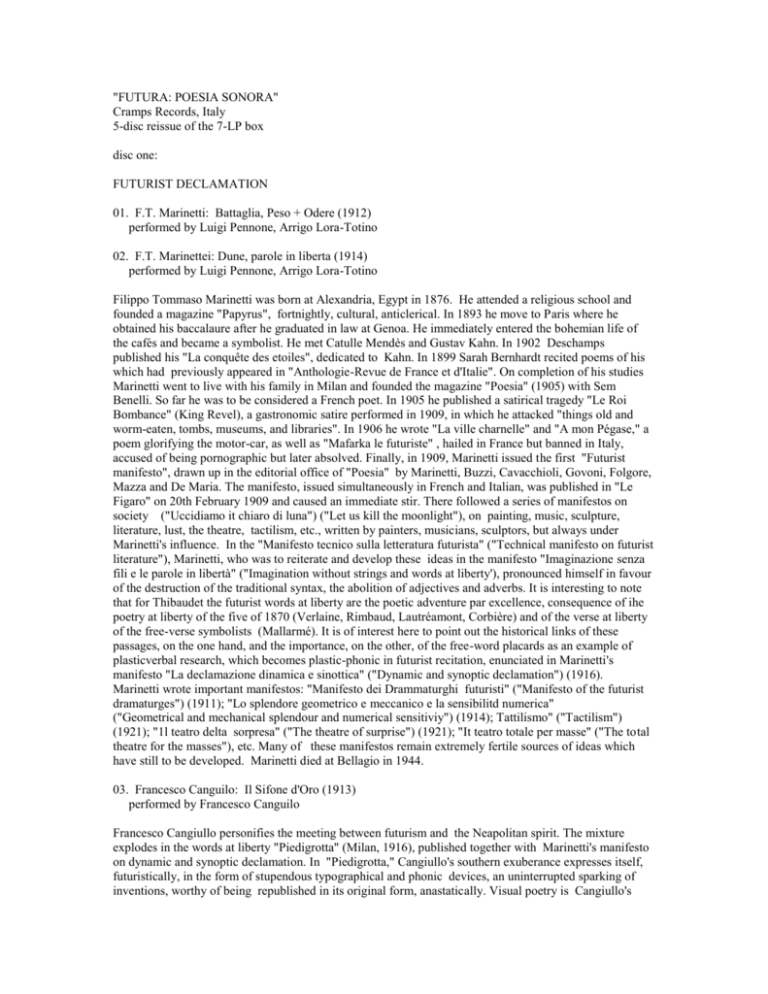
"FUTURA: POESIA SONORA"
Cramps Records, Italy
5-disc reissue of the 7-LP box
disc one:
FUTURIST DECLAMATION
01. F.T. Marinetti: Battaglia, Peso + Odere (1912)
performed by Luigi Pennone, Arrigo Lora-Totino
02. F.T. Marinettei: Dune, parole in liberta (1914)
performed by Luigi Pennone, Arrigo Lora-Totino
Filippo Tommaso Marinetti was born at Alexandria, Egypt in 1876. He attended a religious school and
founded a magazine "Papyrus", fortnightly, cultural, anticlerical. In 1893 he move to Paris where he
obtained his baccalaure after he graduated in law at Genoa. He immediately entered the bohemian life of
the cafés and became a symbolist. He met Catulle Mendès and Gustav Kahn. In 1902 Deschamps
published his "La conquête des etoiles", dedicated to Kahn. In 1899 Sarah Bernhardt recited poems of his
which had previously appeared in "Anthologie-Revue de France et d'Italie". On completion of his studies
Marinetti went to live with his family in Milan and founded the magazine "Poesia" (1905) with Sem
Benelli. So far he was to be considered a French poet. In 1905 he published a satirical tragedy "Le Roi
Bombance" (King Revel), a gastronomic satire performed in 1909, in which he attacked "things old and
worm-eaten, tombs, museums, and libraries". In 1906 he wrote "La ville charnelle" and "A mon Pégase," a
poem glorifying the motor-car, as well as "Mafarka le futuriste" , hailed in France but banned in Italy,
accused of being pornographic but later absolved. Finally, in 1909, Marinetti issued the first "Futurist
manifesto", drawn up in the editorial office of "Poesia" by Marinetti, Buzzi, Cavacchioli, Govoni, Folgore,
Mazza and De Maria. The manifesto, issued simultaneously in French and Italian, was published in "Le
Figaro" on 20th February 1909 and caused an immediate stir. There followed a series of manifestos on
society ("Uccidiamo it chiaro di luna") ("Let us kill the moonlight"), on painting, music, sculpture,
literature, lust, the theatre, tactilism, etc., written by painters, musicians, sculptors, but always under
Marinetti's influence. In the "Manifesto tecnico sulla letteratura futurista" ("Technical manifesto on futurist
literature"), Marinetti, who was to reiterate and develop these ideas in the manifesto "Imaginazione senza
fili e le parole in libertà" ("Imagination without strings and words at liberty'), pronounced himself in favour
of the destruction of the traditional syntax, the abolition of adjectives and adverbs. It is interesting to note
that for Thibaudet the futurist words at liberty are the poetic adventure par excellence, consequence of ihe
poetry at liberty of the five of 1870 (Verlaine, Rimbaud, Lautréamont, Corbière) and of the verse at liberty
of the free-verse symbolists (Mallarmé). It is of interest here to point out the historical links of these
passages, on the one hand, and the importance, on the other, of the free-word placards as an example of
plasticverbal research, which becomes plastic-phonic in futurist recitation, enunciated in Marinetti's
manifesto "La declamazione dinamica e sinottica" ("Dynamic and synoptic declamation") (1916).
Marinetti wrote important manifestos: "Manifesto dei Drammaturghi futuristi" ("Manifesto of the futurist
dramaturges") (1911); "Lo splendore geometrico e meccanico e la sensibilitd numerica"
("Geometrical and mechanical splendour and numerical sensitiviy") (1914); Tattilismo" ("Tactilism")
(1921); "1l teatro delta sorpresa" ("The theatre of surprise") (1921); "It teatro totale per masse" ("The total
theatre for the masses"), etc. Many of these manifestos remain extremely fertile sources of ideas which
have still to be developed. Marinetti died at Bellagio in 1944.
03. Francesco Canguilo: Il Sifone d'Oro (1913)
performed by Francesco Canguilo
Francesco Cangiullo personifies the meeting between futurism and the Neapolitan spirit. The mixture
explodes in the words at liberty "Piedigrotta" (Milan, 1916), published together with Marinetti's manifesto
on dynamic and synoptic declamation. In "Piedigrotta," Cangiullo's southern exuberance expresses itself,
futuristically, in the form of stupendous typographical and phonic devices, an uninterrupted sparking of
inventions, worthy of being republished in its original form, anastatically. Visual poetry is Cangiullo's
debtor for the subsequent "Café concerto, alfabeto a sorpresa" (Café concert, surprise alphabet") (Milan,
1916), in which the typograhical component, employed in a masterly manner, provides a spectacle entirely
without precedent at the time, a sort of printed theatre. "It sifone d'oro" ("The golden siphon") was
published in 1924 (Casella, Naples) but composed in 1913, and was translated into French by Marinetti. It
is declaimed by the author, a hitherto unissue phonic document. It is a great pity that the limited technical
resources of the time has deprived us of recordings of the famous futurist sessions, a form of variety
theatre which was related to the Commedia dell'Arte and at the same time heralded the dadaist Cabaret
Voltaire and the Bauhaus scene. Francesco Cangiullo was born in Naples in 1884, son of a well known
wood sculptor. He initiated classical studies, at his mother's wish but gave them up to dedicate himself to
poetry. In addition to collections of verse, he published novels, short stories and works for the theatre, and
contributed to magazines such as "Lacerba" and "La Fiera Letteraria and to newspapers: "It Tempo", "It
Mattino", "Il Giornale d'Italia". He embraced futurism with enthusiasm and brought to the movement the
fruits of his fertile inventiveness: pentagrammed poetry, surprise alphabet, humanized letters, surprise
theatre. He withdrew in 1924 and continued more independently his work as a writer and poet. He lives at
Livorno and Still continues to contribute literary leading articles to the Roman newspaper "It Tempo".
04. Giacomo Balla: Discussione sul futurismo di due critici sudanesi
(1914)
05. Giacomo Balla: Macchina Tipographica (1914)
06. Giacomo Balla: Paesaggio + Temporale (1914)
07. Giacomo Balla: Canzone di Maggio (1914)
08. Giacomo Balla: Funerale a piazza Termini (1918)
09. Giacomo Balla: Il pigro (c. 1920)
10. Giacomo Balla: L'annoiata (c. 1920)
performed by Luigi Pennone, Arrigo Lora-Totino, Sergio Cena
Futurballa, yes, indeed, Giacomo Balla himself, the necromancer of futurism. Who can say how much
futurism (and post-futurism) owes to him? He quickened painting, painting did not suffice, so onwards,
colourhythmsound, the word, the theatre. Balla picked on the concrete aspect of words at liberty: the
sound. He isolated it, worked on onomatopoeia, making it the primary element of his lightning-quick
"Verbalizzazioni Astratte" ("Abstract verbalizations") and of "Mimiche Sinottiche" ("Sinoptic mimes"). On
March 29th 1914, at the Sprovieri Gallery the "Discussione di due critici sudanesi sulfuturismo"
("Discussion of two sudanese critics on futurism") was performed, that is, improvised, round an out-of-tune
piano, by Marinetti, Cangiullo and Balla, who played the guitar. Balla's text, jotted down in a note-book, is
a witty nonsense which anticipates the "Verses without words" of Hugo Ball at the Cabaret Voltaire:
"Farcionisgnaco gurninfuturo bordubalotaompimagnusasfacataca mimitirichita plucu sbumu farufutusmaca
sgacgnacgnac chr chr stechestecheteretete maumauzizitititititititi". As Fagiolo Dell'Arco rightly points out
"In his rediscovery of the value of sound, Balla goes even further than Russolo, the theoretician of
'Intonarumori': towards pure sound and the timbre-word" , the word-colour and, we add, towards the
disarticulated phoneme. Here is a summary account of "Afacchina tipografica" ("Composing machine"),
performed in 1916, as Virgilio Marchi remembered it:
"One evening we all betook ourselves to the drawing-room of Diaghilev and Semenoff to decide on the
choice of 'Feu d'artifice' or of 'Balletto tipografica', a mechanical invention of Giacomo Balla. For this the
author arranged us in geometrical order and with the chequered grey stick he was never without directed
the machinistic movements and the structures each of us had to perform to represent the souls of the single
pieces of the rotary press of a newspaper. I was responsible for a 'STA', reiterated and violent, to be carried
out with an arm, gymnastically, which gave me the impression of being in the barrack-yard doing exercises.
Balla, needless to say, reserved for himself the hissing sounds, the onomatopoeias' the more delicate
verbalizations which issued from his lips interspersed with that memorable Piedmontese 'neh' and with the
sound of corks being pulled out of bottles of Frascati by the impenitent and bearded Semenoff, which made
everything very intelligently and amusingly grotesque".
And Bruno Corra in Battaglie" ("Battles") (Milan, 1920) recalls that:
"At the futurist premises in Rome in Via del Tritone, directed with lively intelligence by the futurist
Sprovieri, 'Piedigrotta' was declaimed, acted and put into action by Marrinetti, Cangiullo and Balla. From
time to time the author leapt to the piano, while alternating with Marinetti and Balla in declaiming his
words at liberty. The room was lighted by red lamps which doubled the dynamism of the 'pedigrotesque'
back-cloth painted by Balla. The public ceered with wild applause the appearance of our procession of the
troupe of dwarfs, shaggy with fantastic hair made out of tissue paper. Greatly admired was the gaily
coloured ship which the painter Balla wore on his head. Conspicuous in one corner was the bile-green stilllife of three philosophers of the Croce school, amusingly, funereally out of place in the ulta-vivid futurist
setting. Those who believe in art as something joyful, optimistic and divinely carefree carried the doubtful
with them... The public accompanied with voices and gestures the marvellous uproar which broke out from
time to time during Marinetti's declamation, which was very clear and efficacious in its merging with the
onomatopoeic instruments ( ... ). At the futurists' Roman premises and Balla's house at Via Paisiello 39,
Cangiullo collaborated with Balla and Marinetti in creation of numerous volcanic futurist fantasies. Typical
is the funeral of a philosopher- critic: a large tragicomic procession , the young futurists disguised as stove
pipes and the corpse sculpted with slaps by Cangiullo and carried on a stretcher, the procession solemnly
led by Balla, striking an enormous cowbell with a large painter's brush, murmuring funereally. Balla, apart
from being the great dynamist-futurist painter and the most tireless intuitive and generous discoverer and
inspirer of young artists to be liberated, encouraged, centuplicated and launched forth, is also the renovator
of the guitar. From the guitar he draws forth landscapes, burlesque scenes, protesting crowds, rains, hail
storms, battles, etc. Mixing dialogue with sound and with noises of the mouth, he has created such
prodigious fantasies as the 'Lezione di equitazione' ('Riding lesson') and the 'Vignaiolo dopo il temporale
('Vine-dresser after the storm'). His very comic and ironic abstract verbalization of a 'Discussione sul
futurismo di due critici sudanesi' ('Discussion on futurism between two sudanese critics') is frequently
performed to applause in Roman drawing-rooms." "Funerale a Piazza Termini" ("Funeral in Piazza
Termini"), dated 1918 is akin to "Per comprendere il pianto" ("To understand weeping"), 1916, in the sense
of Palazzeschi's proposal in "Controdolore" to "transform funerals into masked processions". "Canzone di
maggho' ("May song") aims at a graphic representation of the rhythm of growth of a flower, but the
optophonic penetration is evident. Balla writes: "silence of velvet, words of every colour" an we shall have
acrobatic blocks of colours arranged like the following words : Caffèangocase, Rosvérbastocap, etc. ' Thus
was Balla; in Marinetti's words: "He had the lively carefreeness of a stream frolicking with the flowers and
with the rosy feet of children. Late at night, bedded down in the Roman countryside, his face to the zenith,
he talked to the constellations, seeking to steal their wood, he was gazing through half-closed eyes at a high
jet colourde by iridescent gems". "And off a hurry, between the oblique rays of a barbaric sunset that,
fleeing, fought against the white explosions of the electric lamps. We observed him joyful as he risked
getting us run over by the cars, for Balla loves to be grazed by wheels and mud-guards in order to taste
danger and to exercise his elasticity."
The name and paintings of Giacomo Balla are too well known to require here a detailed biography. We
shall mention only that he was born in Turin in 1871 and move to Rome in 1895. In 1900 he worked for
seven months in Paris and, in 1910, with Boccioni, Carrà, Russolo and Severini, was a signiatory of the
"Manifesto dei pittori futuristi" ("Manifesto of the futurist painters") and the "Manifesto tecnico della
pittura futurista". ("Technical manifesto of futurist painting,"). Very active in the movement, he was also
the teacher of Prampolini and Depero. His works were included in numerous exhibitions of the futurist
group. In 1916, with Chiti, Carrà, Ginna, Marinetti and Settimelli, he was a signatory of the manifesto
"Cinematografia futurista" ("Futurist cinema") and in January 1917, with the other signatories of the
manifesto, made the short film "Vita futurista" ("Futurist life") in Florence. In 1917 Stravinsky's "Uccello
di fuoco" ("Firebird") was performed at the Costanzi Theatre in Rome, with Diaghilev's dancers and Balla's
décors. After the Second World War, and a period in which he was ignored even by the so-called
authoritative critics, it was the painters who rediscovered him: the "Origine" group (Mario Ballocco,
Alberto Burri, Ettore Colla, Giuseppe Capogrossi) organized an exhibition of his futurist and abstract
works in the group's premises and the painter Piero Dorazio studied his work, particularly that of the period
of "iridescent compenetrations" (1912-14). He died in Rome in 1958.
11. Fortunato Depero: Tramvai (1916)
12. Fortunato Depero: SiiO VLUMMIA - torrente (1916)
13. Fortunato Depero: Verbalizzazione astratta / Di signora (1916)
performed by Luigi Pennone, Arrigo Lora-Totino, Sergio Cena
Fortunato Depero, both in his painting and in his poetry, took Balla as his starting-point. But his interest in
poetry gave rise to a number of publications which enable him to be considered, not only a great painter,
but also one of the most interesting Italian poets of the early 20th century. In 1916 he published the
manifesto l'onomalingua. In his "Verbalizzazioni Astratte" ("Abstract verbalizations"), Depero
developed the onomatopoeic invention to the point of paroxysm and, in a certain sense, left it behind. For
Depero the poet, onomatopoeia is a problem of language, the language of natural forces developed to the
maximum of sonic intensity. Depero does not describe the object or the sensation or the state of mind, he
makes them act sonically.. sex whimpers its timidity stammeringly in "Verbtilizzazione astratta di signora"
("Abstract verbalization of a lady"), a canine appetite shrieks in "Trarrivai", water gurgles in "SiiO
VLUMMIA - Torrente", the Brindisi all'hotel 5th Avenue" ("Toast at the Fifth Avenue Hotel") fans the
peals of bells, the crowd in "Broadway" riots. "Avoid giving to material human sentiments but, rather,
intuit its different directive impulses, its forces of compression of expansion, of cohesion and of
disintegration... It is not a case of rendering the dramas of a humanized material. It is the solidity of a sheet
of steel that we are interested in for its own sake, that is, the incomprehensible and inhuman alliance of its
molecules and electrons... the heat of a piece of iron or of wood is now more vitally interesting to us than
the smile or tears of a woman" (Marinetti). The technique of Depero's onomalanguge develops these
concepts. Depero really succeeds in animalizing, vetetalizing, mineralizing, electrifying or liquefying style"
(Marinetti). The obsessive intensity of his operation is extreme and so must his declamation have been, as
Carlo Belli recalls: "I can still hear his extraordinarily mobile voice when he recited to me:
Ambla no-òffa embla carèmba n narici pèndule matercolòstro
I did not always have the power to look at him in the moment when he broke into these sonic rigmaroles
according to the intensity, the fatness or leanness of the sounds, his lips twisted to express a violent disdain,
his face was suddenly illuminated, or his eyes narrowed to ferocious pin-heads of tar. He wrote a lot and I
dilligently copied it and then lost the copybook. (from "Memory of Depero" in Catalogo Depero, Bassano
del Grappa, 1970). Fortunato Depero was born at Fondo (Trentino) in 1892; his father was first a
chimneysweep and later a policeman of the Austrian empire. For a year he was an apprentice to the marblecutter Scanagatta at Rovereto, to where his family had moved. His first exhibition was in 1911 at the
Giovannini stationery shop in Rovereto; two more exhibitions followed. In 1913 he published "Spezature
Impressioni - Segni - Ritmi" ("Pieces. Impressions - Signs - Rhythms"), a collection of prose, poetry and
reproductions of grotesque and symbolistic drawings. In the same year, he visited Boccioni's exhibition at
the Sprovieri gallery in Rome, which made a deep impression on him. In 1914 he frequented the gallery
and met Balla, Cangiullo and Marinetti, exhibited at the galley, was "scetavaiasse", one of the five "famous
dwarf artists" at the first dynamic and synopticdeclamation of Cangiullo's poem "Piedigrotta" and took part
in the "Funerale del filosofo passatista" (Bene etto Croce) ("Funeral of the traditionalist philosopher"). In
collaboration with Balla he formulated the ideas for the famous and fundamental manifesto "La
ricostruzione, futurista dell'universo" ("The futurist reconstruction of the universe"), which was issued on
March I Ith 1915 and signed by "Balla Depero futurist abstractionists". In the same year he prepared the
poetic manifesto of "Onomalingua" and in 1916 composed various s and onomalinguistic poems and held a
large exhibition (200 works) in Rome, which included free-word placards, paintings, drawing, plasticmotornoise complexes, sketches for theatrical costumes. In 1917 he worked on the construction of the
plastic set and the 35 plastic- mobile costumes for Stravinsky's "il canto dell'Usignolo" ("The nightingale's
song"), which was not performed. He illustrated Gilbert Clavel's short story "Un istituto per Suicidi" ("An
institute for suicides"). 1918 saw the performance at the Teatro dei Piccoli, Rome, of Depero's "Balli
Plastici" ("Plastic dances"), performed by the marionettes of the Compagnia Marionettistica Dell'Acqua,
with music by Casella, Malipiero, Bartok. In 1919 his article: "Il teatro Plastico Depero - Principi e
applicazioni" ("The Depero plastic theatre - Principles and applications", was published in "Il Mondo". He
founded the Casa d'Arte, a factory producing furniture and decorative objets d'art in order to integrate art
with the functions of life (Bauhaus). In 1921 he designed the "Cabaret del Diavolo" for Gino Gori. In 1924
the Compagnia del Nuovo Teatro Futurista opened in Milan with Depero's mechanical ballet "Anihccam
del 3000" (music by Casavola). In the meantime his works were shown in numerous personal and joint
exhibitions both in Italy and abroad. In 1927 he presented "Padiglione Tipographico" ("Typographical
pavilion") on behalf of the publishing houses Bastetti - Tumminelli - Treves at the 3rd International
Exhibition of the Decorative Arts at Monza. In the same year Dinamo Azari published the Riveted Book
"Depero Fulurista" ("Depero the futurist"): a summary of Depero s work from 1913 to 1927, including his
literary work, and an unequalled example of innovatory graphics. In 1928 he left for the U.S.A. where he
held some exhibitions of his works and designed the costumes for Massine's ballet "Amerikan Sketches,",
music by Griselle. In 1931 he planned the free-word and sound book (two records of onomalinguistic
declamations) "New York - Film vissuto" ("New York - film experience"). In the following year the
magazine "Dinamo", founded and edited by Depero, was published at Rovereto; five numbers were
published. In 1934 "Liriche radiofoniche" (Radiophonic Lyrics") (Editore Morreale, Milan) was published.
In 1940 Legione Trentita published "Fortunato Depero nelle opere e nella vita" ("Fortunato Depero, his life
and works") at Trento. During the Second World War he gave radio readings of onomalinguistic poems. He
had already given radio readings of his poems. On November 23rd 1933, from Milan, he declaimed "Poesie
Americane" ("American poems") in a Santagostino advertising program and, in 1934, from Rome,
"Dinamismo, di una Sifora Metropolitana" ("Dynamism of a metropolitan lady") and, from Genoa,
"Bambola Felice" ("Happy doll") in Pirelli advertising programs (cf. notices in Radiocorriere of 18/3/34
and 25/3/34). In 1947 he published, in English, the volume "So I think - So I paint". In
1948 he returned to New York where be held two exhibitions. 1950 saw the publication of the "Marqesto
della pittura plastica nucleare" (Manifesto of plastic nuclear painting). In 197 the municipal administration
of Rovereto decided to found the Depero Permanent Gallery and Museum for the collection of the artist's
works. On the occasion of the opening of the museum in 1959 an honorary committee was instituted, with
among the promoters: J. Arp, Bragaglia, N. Gontcharowa, M. Larionov, B. Munari, G. Vantongerlo.
Depero died at Rovereto on the 29th November 1960.
14. Farfa: Tuberie (1937)
15. Farfa: Sincopatie - Innazi al - Le Rondini Apersi - Il Mattino Luna Erotomane (1933)
16. Farfa: Affaraffari (1947)
17. Farfa: Veni Vidi Viti (1937)
performed by Luigi Pennone
Luigi Pennone, "the highest pennon of Farfaian declamation", as Farfa himself described him in 1933,
reads us some poems by this extraordinary mixture of childish candour, massive ignorance, iridescent
malice and vulcanic fantasy, this "anomalous body" in the world of culture, virgin as crude and powerful as
a force of nature. This was Marinetti's introduction to the collection of ems "Noi, miliardario della
fantasia" ("We millionaires of fantasy") (1933) which he himself had selected from thousands of Farfa's
works, and he chose no less than two hundred and sixty-six:
Farfa National futurist. poetry record-man
The poetry circuits are arousing the lively interest of the Italian literary world. Sport is entering
triumphantly into poetry, enhancing its elasticity, its heroic leaps, its tireless dynamism. We have finally
emerged from the mephitic atmosphere of libraries and museums, The muscular surge and the roar of
engines impose new rhythmic laws and prepare us for the great aeropoetry. We can feel its vibrations in
crowd which has assembled to listen, to discuss, to applaud, to scoff, but which is already learning by heart
the spiralling lyrical glorifications of Sant'Elia, architectures flying from the mouth of Farfa, poetry recordman of Milan, Tullio d'Albisola, poetry record-man of Turin, Krimer, poetry record-man of Rome,
Fortunato Bellonzi, poetry record-man of Genoa, Emilio Sasso, poetry record-man of Florence, Burrasca,
poetry record-man of Trieste, Bruno Sanzin, poetry record-man of Chiavari and Vianello, poetry recordman of Verona. In inviting me to listen to his latest lyrics, the futuriste poet Farfa said to me: You will hear
all manner of incredible things" Exactly. Farfa, cubic, full-chested, declaims like an internal combustion
engine, his square face turned towards the ceiling-and his eyes closed by the force of short-sightedness. His
very short lyrics are:
1. Solar laughs of the sea.
2. Surprise poems.
3. Poems composed of enormous antitheses.
4. Radio poems with transoceanic wave-jumps to revenge himself for his shortsightedness.
5. Hallucinating with a visionary force and a futurist imagination without strings, which annul all the values
of reality. Farfa's New
York, Paris, London, Berlin, Moscow are absolutely his own, invented by him and more surprising than
reality.
6. Spiral and tortuous poems seeking always to extend the horizon.
7. Poems syncopated by an unrestrainable dance of other unexpressed ideas and internal intuitions.
8. Firework poems with a very high ascent, extensive rain of gold and 2 3 4 5 final bangs.
9. Journalistic poems, that is, triggered off by electrical sparks between two news items in an aerial
crossroads of Stefani, Havas, New York Times.
10. Stone-throwing poems, as defined by Depero.
11. Horse Power collars with bells and child calorie toys.
Insatiably Farfa drinks up the thunderous applause that greets his lyric to Sant'Elia in the Poetry Circuit of
the Ganeria Pesaro in Milan. The Futurist Farfa by myself crowned with an aluminium helmet in the
cockpit of a small Caproni at a height of 1,000 meters in the sky. But his engine has incalculable reserves.
His Journalistic passion is powerful enough to raise the contraption with the engine off, cause a bloody
brawl in the cockpit between the pilot and mechanic, and precipitate ever everything into the sea, just so
long as Farfa can radiotelegraph the flying news: "First of them all. Farfa national poetry recordman".
(F.T. Marinetti)
Farfa's poetry is founded on alliteration and this is its phonic dimension, rather than onomatopoeia which,
unlike the other futurist authors, he disregards, just as he prefers free verse to free- word experiment. The
text is corded with assonances, consonances, homonyms. Often descending to the level of mere punning,
sometimes, however, they create purely, euphonic orchestrations. The words, often distorted, melt and
dissolve into a single sonic mixture. This is the case of ' Tuberie", ("Piping"), included in the abovementioned volume published in 1933, and of "Veni vidi viti" which in 1937 won the Siena national
competition for a "Bacchic amorous and martial" poem, as well as of "Affaraffari" (1947). They are rather
long texts. But Farfa -- Marinetti had said "our acts may be instants" - referred the "Sincopatie", a sort of
"tanke" which in fact found favour in Japan where some were translated and included in school text-books.
Farfa (Vittorio Osvaldo Tommasini) was born at Trieste in 1879. Of robust physique and enviable good
health, at eighty he was as he had been at fifty: a cubic wardrobe of energy. Very short-sighted from
childhood, he saw men and things in a halo of mist. His encounter with Futurism took place at Trieste on
the occasion of the futurist evening on January 12th 1910. He met Marinetti for the first time in Turin, to
where he had moved with his mother, in 1919. In the same year he founded the Turin Futurist Group with
Fillia, Diulgheroff, Pozzo, Mino Rosso and Oriani. He worked for Fiat as a mechanic but an accident
dissuaded him from continuing, as well as inspiring the poem "Tenerezze Fresatorie" ("Milling
tendernesses"). He tried painting, sculpture, graphics, above all collage, in works that he called
"cartopitture". In 1929 he settled at Savona, where he made friends with Tullio d'Albisola. He died in 1964
at Sanremo following a car accident. In 1970 his friend Luigi Permone edited the collection of his lyrics in
a volume titled "Farfa, poeta record nazionale futurista" (Sabatelli, Savona).
'ZAUM', TRANSMENTAL LANGUAGE
18. Vladimir Majakovskij: Rumori, Rumorini, Rumoracci (1913)
19. Vladimir Majakovskij: Di Strada in strada (1913)
20. Vladimir Majakovskij: Ordinanza all'esercito dell'arte (1918)
performed by Valerij Voskobojnikov
Vladimir Vladimirovic Majakovskij (1894-1930) is too well known to require a detailed biography. He was
born in Georgia in the village of Bagdad the son of a forestry inspector. Afterl his father's death in 1906 he
moved to Moscow. In 1908 he left school to dedicate himself to political activities. He joined the illegal
Bolshevik party and was arrested three times. In 1911 he entered the Moscow Institute of Painting,
Sculpture and Architecture where he met David Burlifik, who encouraged him to write poetry. An adherent
of cubofuturism, with other futurists he toured southern Russia at the end of 1913 and the beginning of
1914. In October 1915 he was conscripted and posted to the motorization school at Petrograd as a
draughtsman. He greeted the Revolution with enthusiasm. In November 1918 his drama "Misterija Buff'
("Funny Mystery") was performed . From 1919 to 1922 he worked at the Rosta (Russian Telegraphic
Agency). He went abroad on a number of occasions, preferring Berlin and Paris; in 1925 he visited
America. In 1926 he travelled extensively in the Soviet Union tirelessly reciting his poems. Early in 1930
he organized a exhibition of twenty years of his literary work at the Writers' Club in Moscow. He died,
apparently by suicide, on the 14th of April of the same year.
21. Velemir Chlebnikov: Bobeobi (c. 1908)
22. Velemir Chlebnikov: Esorcismo col riso (1908)
23. Velemir Chlebnikov: Il Linguaggio degli dei (from Zanzegi) (1922)
24. Velemir Chlebnikov: Il Linguaggio delle stelle (from Zanzegi)
(1922)
performed by Valerij Voskobojnikov
Velemir Chlebnikov (1885-1922) requires lengthy consideration, for sound poetry on the one hand
accounted for a large art of his poetic work and, on the other, was the object of much of his "theoretical"
and programmatic elaboration. Confining oneself to a Summary account of the Chlebnikovian zaum, as the
result of his creative inheritance, one can identify three underlying principles. First of all verbopoesis
(slovotvorcestvo). Chlebnikov was an assidious worker of verbal materials, a relentless excavator in the
vocabulary: the sound of a root induced him to imagine in it a significative potential that the common
language had not developed. Working with) prefixes and suffixes, substantivizing adjectives and
verbalizing nouns, he created a magical linguistic overworld in which he moved with absorbed mien:
"verbal formation by way of the morphological mutation of words is transformed in Chlebnikov from a
linguistic experiment into an aesthetic fact" (Stepanov). The second principle of Chlebnikovian zaum is
phonowriting (zvukopis'), which induces him to seek in words a phonic-emotive expressiveness in
complete discord with the meanings, to the point of conferring on single syllables - often intuitively
extracted from series of words able to be considered homogeneous as regards some feature - independent
meanings, which he meticulously listed. Here again the laboratory is transformed into aesthetic hypothesis,
and phonowriting gives rise to a whole series of phonoimages (zvukoobrazy) of his poetic writing. The
third principle, finally, is the mental alphabet (azbuka uma), which seeks to construct a language for
hieroglyphs of abstract concepts, rendered by absolutely arbitrary lemmas, and is sometimes called the
"stellar or "universal" language. Here the Chlebnikovian "zaum"' attains its highest point of rarefaction, and
only conventionally can one speak of its possible decipherment. Chlebnikov's creativity was naturally far
more complex than might appear from this account, and in fact he often combined a number of different
"transmental" forms. It should be said, furthermore, that his inexhaustible inventiveness - reflected in his
far from systematic research - tended to see systems in what never got beyond beyond an intuitive project:
in the notes on 'Zangezi', for example, one reads that he would have liked to have used no fewer than seven
types of language in that theatrical text: 1) Language of the birds, 2) Language of the Gods, 3) Stellar
language, 4) Transmental language 5) Decomposition of words, 6) Phonolanguage, 7) Language of
madness. Since it is clearly impossible to illustrate ail the forms of Chlebnikovian language, we have
confined ourselves to giving four pieces which are adequately exemplary (of theree models indicated
above. The first text, "Bobeobi" (1908) is perhaps one of Chlebnikov's best known compositions, a
phonopainting (the face is explicity protected "on to the canvas") based on phonic analogies which can
even be translated, on the basis of his note-books (b = red, m = pale blue, p = black, and so on); but which
should above all be referred to a in serious relationship between sounds and colours, already proclaimed by
Rimbaud in his famous "Voyelles"(1871). According to Chlebnikov this was the dawn of phonowriting. In
"Exorcism with rice" (1906-8), another emblematic text, we find the archetype of verbopoiesis. The
rituality of exorcism (which induces the attribution of a shaman-like intonation to the conception of poetry)
contributes to the transformation of the work on the root of smech (= rice) into a sort of linguistic initiation
ceremony. Clearly, this is onl one of the man possible variants of Chlebnikovian verbopoiesis, and one of
the more elementary; but, perhaps for that very reason, it is also one of the most efficacious. The two
exerpts from "Zangezi" (1922; but the first of them comes from the play "The gods", 1919, and the second
is a re-elaboration of the poem ."A scratch on the shy", 1920) illustrate respectively the "Language of the
Gods" and the "Stellar language". The first piece, the speeches of gods of different and incongruous
mythologies, is a limpid example of what we call the mental alphabet: an attempt at pure sound, devoid of
any objective referent, only some phonic connections very distantly imitate linguistic realities out de the
text (thus, the piling up of consonants in the speech of the African god Unkulunkulu), and only a few
syllables can be traced back - as can be deduced from scene XV of "Zangezi" - to the grammar of
phonowriting ("Mam-emai is the, Sky/ Puc e capi a black jackdaw ...). The second piece, proclaimed by
the protagonist himself to be in "stellar language", is a by now polished model of phonowriting, where with
terse pedantry the sonic resonances become the interpretation of being. Velemir Chlebnikov was born in
1885 at Toula and died of septicaemia in a remote village in the Governorate of Novgorod. His life was an
eternal vagabondage. Many of his works, especially from the 191 -18 period, have been lost. The edition of
the complete works is in five volumes: "Sobranie Proizvedendijj-" edited bJurij Tinianov and Nikolàj
Stepanov (Leningrad, 1928-33). He was the most complete poet of the first period of Russian futurism.
According to the poet Mandelstam,"he dug the underground tunnels towards the future for an entire epoch".
Viktor Sklovskij affirms that "Majakovskij, Aseev, Pasternak, are derived from Chlebnikov... he is a
writers' writer."
25. Vasilij Kamenskij: L'Usignolo (1916)
performed by Valerij Voskobojnikov
Vasilij Kamenskij (1884 -1961) was one of the first futurist poets. He was fascinated by modernolarty (he
dedicated himself with passion to the futurist art of flying) but also pervaded with anti- urbanization
feelings, which, in the context of the group, brought him closer to Chlebnikov. In Kamenskij the attraction
of the word as such started in visual terms: thus, in his "Zelezobetonnye poemy "(poems of reinforced
concrete) "the visual aspects eliminate virtually all the others, and it is almost impossible to read these
poems. aloud" (Markov). But Kamenskij. at the same time also concerned himself with phonic
instrumentation, in particular with the possibilities offered by onomatopoetic procedures (which
nonetheless led to verbopoietic solutions, but of a very particular nature). Here a melodic line came
increasingly to prevail, which, as in the case of "Nightingale" (1916) long exerpts of which are here recited,
led to a sort of recovery of the sound of the Russian earth: a form of rustic Eseninism with futurist
instrumentation. In a lecture in that year, at Perm', Kamenskij affirmed that: "The poetry of Modernity...
has divided, stands on opposite banks. The poets on one bank use the word only as a means... The poets on
the other bank, the left bank, have put forward the slogan: down with the word as a means, long live the
self-spun, self-coloured word. If from one bank, the right bank, one hears only songs, from the other, the
left bank, songs deafened by music. By the music of the self-spinning, self-colouring, self- significativity of
the words. Here each word answers for itself. A link between words is not obligitory, because the chords
of music speak for themselves". And in the poem, "Nightingale" (which is concerned with themes and
motifs elaborated previously e.g. in the poems "Cjurlju-zurl" (1910) and 'Ya" (1914), one experiences the
miracle of a nightingale's trill that speaks in an intelligible way: they are the finest fruits of that refined
"zonglërstvo (jugglerism) which was by way of being Kamenskijj's trademark. Vasilij Vasilevic
Kamenskij (1884-1961), futurist poet, was one of the first Russian aviators. Author of a number of small
volumes of memories of great interest from the point of view of the history of early Russian futurism, the
most curious of which is perhaps the anarchical "Ego-moja biografoa velikogo fulurista" (Ego-my
biography of the great futurist, Moscow, 1918). As a visual poet he created a number of poems of refined
verbal architecture, with the title "Poems of reinforced concrete."
26. Aleksej Krucenych: dyr bul scyl (1912)
27. Aleksej Krucenych: Kr dei macelli (1920)
28. Aleksej Krucenych: Zanaera, veleno (1922)
performed by Valerij Voskobojnikov
In a booklet of 1922 which summed-up a decade of experiences of the "Zaumniki", Aleksej Krucenych
(1886-1968) indicated three main aspects of their verbal creations:
1. The most cheerful entertainment
2. The intense phonic technique (instrumentation and of words)
3. The discovery and deciphering of the riddles of words and the universe. But all three of these aspects (or
principles) of "zaum"' as Krucenych understood it were already resent, though still in embryonic form, in U
first elaborations, in particular those collected in the brochure "Vzorval" (Explodity), 1913.
Here some essential models of transmental language were proposed: in the first place ecstatic gIossolalia:
"Emotion cannot be compressed into coagulated words, concepts: the torments of the word are a
gnosiological solitude. Hence the tension towards a transmental language, it is to this way of expressing
himself that man has recourse in the most solemn moments. Here is a model, the discourse of the 'chlyst'
(sectarian) V. Siskov: NOSOKTOS LESONTOS FUTR LIS NATRUFUNTRU... Here the authentic
expression of the soul in ebullition, religious ecstasy, is manifest". (Roman Jakobson, too, referred to the
verbal sayings of the prophet of the "chlysty", Varlaam Siskov, in his essay on Chlebnikov's poetry, in
1921). This was the principle underlying Krucenych's poems of consonants, such as famous "Dyr bull
scyl" (here recited), or composed solely of vowelss: " 0 E U/ 0 U 0/ A E/ E E/ I I/ U J U. Another model
presented in that brochure were the Japanese, Spanish and Hebrew poems, the first two groups composed
of words without sense which initiated the sounds of the languages in question, while the last consisted of a
bad word written with characters imitative of Hebrew script: both types of poem came under the heading of
the most cheerful entertainment". The last aspect of "zai,"', the deciphering of the riddles of words and of
the universe, gave rise to the most constant and organic elaboration of Krucenych's poetic work, semantic transfer (sdvigologija). This was the Krucenych the 'zaumnik", the "Jesuit of words" (as Majakovskij
described him), pedant and tireless verbal jugller. Between the activity of the cubofuturist years
(approximately 1912-14) and that of the left wing Moscow futurism (1922-28) lay the most extreme and
strange period of Krucenychian "zaum"', when he worked at Tiflis (Tbilisi, Georgia) in the years 1917-20.
In this period, the most tormented and tragic of the evolution, Krucenych gathered round him poets such as
Zdanevic and Terent'ev, Tat'jana Vercorka (Tolstaja) and Katanjan, under the illusion of bringing into
being a school of transmental poetry. 'In the midst of so much confusion, Krucenych was the central figure,
the epitome of futurism. For the first time in so many years he played the central role, and this gave him
wings... It was in the Caucasus that he matured on the theoretical plane, and his subsequent publications in
Moscow are the result of the years spent at Tiflis" (Markov). The other two texts here recited, "Boen-Kr"
(which we have translated approximately as "Krucenych of the slaughter-houses" and "Otrava" (Poison) are
the most significant and compendious fruits of these . In the former, nonsense plays an essential role,
linking its frenetic sonic inventivity to dadaistic proposals (a broken brake that causes a cascade of
consonantal screeches; a lock worthy of the most metaphysical incongruities that will be typical of the
"oberiuti");. the latter is the triumph of Z composition (theorized by Krucenych in "Faktura slova",
Moscow, 1923), founded on a predilection for this sibilant which was shared (with a different lightness and
magic, it should be said) by Chlebnikov. Aleksej Eliseevic Krucenych was born at Tunductovo in Volinia
in 1886 and died at Moscow in 1968. A futurist poet, he was the most deeply committed theoretician of the
movement and the author of a number of very important programmatic declarations of Russian futurism.
An extreme advocate of zaum"' (transmental language), and characterized by a proto-dadaist irreverence,
he published, with Chlebnikov, numerous collections of poems. Between 1917 and 1920 he headed, at
Tiflis, the group of transmentalist of the "41st company." Krucenych published over 150 volumes of verse,
programmatic declarations, polemics, memoirs, his own and of others. Returning to Moscow after 1920, he
made a notable contribution to increasing the very limited diffusion of literary texts of the 1920s.
Krucenych was the first to break up the wood of words into logs and kindling for burning, and with an
indescribable pleasure inhaled the fresh smell of the verbal wood" (Tret'jakov). His 1921 manifesto
"Declaration of the transmental language" is an important landmark in the history of sound poetry. Some of
his more important publications: "Igra v adu" " (Moscow, 1912-13), Mirskonca" (Moscow, 1912),
"Starinnaja ljubov"' (Moscow, 1912), "Pomada" (Moscow, 1913), "Slovo kak takovoe" (Moscow, 1913),
"Vzorval"' (St Petersburg, 1913), etc. Also of note, under the phonic aspect, is the theoretical work
"Fonetika teatra" (Moscow, 1923
29. Il’ja Zdanevic: Scena da “Asino a nolo” (1918)
A trio from "Donkey for hire" by Il'ja Zdanevic (1894-1973) exemplifies the extreme formulation, of
"zaum"', more organic and radical, but also more abstract, at the limits of absolute incomprehensibility; and
of that particular variant of "zaum"' that was developed at Tbilisi by the 41 Degrees company. "Asel
naprakat "(written in 1918 but published in 1919 in one of the few editions of the 41 Degrees company, the
miscellany in honour of the actress Sofija Mel'nikova) is the second of die dra - initiatory lemma for
theatrical composition, but evidently derived from drama - of which Zdanevic's pentalogy is composed:
preceded by "Janko krul albanski" (Janko, Albanian king, 1916) and by "Ostraf Paschi" (Easter Island,
1919), "zga Jakaby "(AS IF ZGA, 1920), and finally "lidantjU fARam" (LidsentU like a lighthouse), which
Zdanevic, formerly "Eli Egambjuri", and now finally "Il'jazd", published as an emigrant in Paris in 1923.
From the point of view of semantic decodification, the "zaum" used here by Zdanevic appears as an
indistinct phonic chain in which, from time to time, Russian roots or words are barely recognizable, often
mangled in their pronunciation and, in every case (beginning with the titles) in their graphic form is an
attempt to imitate speech. As has already been pointed out, in "Donkey for hire" the verbal mixture,
fundamentally Russian, is enlived by a flavour of languages (thus adopting one of the characteristic
Features of "zaum" of Krucenych, the "writing in languages"). Like Zdanevic's other "dra", "Donhey for
hire" is a composition for "vertep" (the Ukranian Nativity theatre, in which the sacred action is
accompanied by profane anecdotes, similar to the puppet theatre in type): it is known to have been
performed in Paris in 1923, in a puppet theatre, the speaking being done by Zdanevic hinself. The
mumbling of the four characters (Zochna, the two suitors, the donkey), the sketchy plot, strange and
motiveless as those with which even today the Gianicolo puppet-masters entertain the "good children",
have the flavour of infantile theatricality,of the primitivism of puppets. The action hinges on the courting of
Zoching: one suitor transforms himself into a donkey, for which Zochna falls in love with him; whereupon
A and B plan to put a real donkey in his place and Zochna (who appears in bridal dress) flirt with it; A
reveals the deception to her, and receives her favours; but it is causes trouble with B and the two kill each
other in a brawl, leaving Zochna to bewail her misfortune. It is impossible not to notice that this infantile,
puppet- theatre -type of work contains elements of -harsh sexual caricature: here we have that "anal
eroticism", that "small nest of indecent words" which was the Krucenychian variant of Marinetti's antifeminism. However, speaking of "Donhey for hire", Terentev emphasizes, instead, its tenderness and
gentleness, the saliva of love, and even detects an irresolution A la Ibsen ("Rekord neznosti, Memory of
tenderness, Tiflis, 1919). This observation, rather than to the plot and motifs, is to be referred to the quality
of the "zaum "'employed, and to its orchestration. It is in fact a composition in which the musical effects are
absolutely pre-eminent and in which, as in the exerpt here performed, the characters speak simultaneously,
giving rise to a subtle interplay of accords and dissonances, underlined by the superimposition in unison of
some vowels, or syllables: for example, the braying of the donkey ( I-A-I-A ... ) coincides with B's
exclamation "JA JA" (I, I !) and with the vowels i and a of the words pronounced by A, in particular the
long conclusion of "onà" (her). From this singular orchestration of the voices derives the even more
singular graphic solution of the printed text (which became the model for the "dra"), in which, as in a
musical score, the words for the three voices are printed in a superimposed manner, with large letters to
indicate the phonic community of vowels and -consonants common to two or more voices. In this way
Zdanevic"s page acquires a mysterious and esoteric, but also fascinating, appearance. We are here at the
height of what could be called Russian dadaism. Ilya Zdanevic(Iliazd) was born at Moscow in 1194 and at
a very early age frequented the first avant-garde poetry groups formed in Moscow. Adopting the techniquie
of Chlebnikov's linguistic "iliumism", to which he gave a greater phonetic contrast by isolating it from the
lexical panmongolism typical of that poet, in 1919 Iliazd published his first collection of zaumist verses:
"Easter Island" (Moscow, 41 Degree editions). Immediately following the October Revolution he
immigrated to Paris where he took part in the activities of the French dada group. On 6th July 1923 he was
one of the organizers of the dadaist evening at the Michel Theatre in Paris, when Tristan Tzara's "The gas
heart" was performed. In the same year 4 1Degree editions published his fundamental work: "Lidentu like a
lighthouse", a dramatic poem in "zaum"' language. This volume remains an unsurpassed example of
visually fascinating typographical contrivances and was to exert a decisive influence on the typographical
component of international dadaist poetry. After long years of silence in which he was engaged, above all,
in the diffusion of the grapic work of Picasso, Iliazd, in Paris in 1949, selected and edited, again for 41
Degree editions, the collection "Poisie des mots inconnus ", which included poems by Akinsemonyin,
Albert-Birot, Arp, Artaud, Audiberti, Elall, Beaudin, Dermée, Huidobro, Iliazd, jolas, Klebnikov,
Krutchonych, Polavski, Schwitters, Seuphor, Terentiev, Tzara. The volume was illustrated by Arp, Braque,
Bryen, ChaFgall, Dominguez, Ferat, Giacometti, Gleizes, Hausmann, Laurens, Léger, Magnelli, Matisse,
Misson, Metzinger, Miró, Picasso, Survage, Taueber-Arp, Tytgat, Villon and Wolls. In 1968 he published "
Rogelio Lacourière, pêcheur de cuivre - aux quatre coins de la piece", a "zaumist" poem suitable for
theatrical presentation, published by 41 Degrees editions under the author's supervision.
